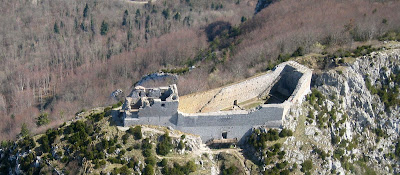Glastonbury is a small town in Somerset, England, that has been inhabited since Neolithic times. A recent post discussed the discovery of early medieval glass-making furnaces at the site of the now ruined Glastonbury Abbey. This prompted some to point out to me that Glastonbury "must have been known" for glass production—it is "right there in the name." Let us address that.
In his book The Flowering Hawthorn, Hugh Ross Williamson tells the story of St. Collen. Collen was a 7th century hermit who took up residence at what is now Glastonbury. Williamson relates how the saint encountered Gwyn, King of the Fairies, in a magical glass castle on Glastonbury Tor. Rejecting the fairies' offer of food and drink, he cast holy water on them, causing all to vanish. Numerous versions of this story exist, but Williamson's 1962 book is the only version that introduces glass as the material involved. As a source for the site's name, this is not reliable.
William of Malmesbury refers to its earliest name as Ynys Witrin, which some translate as "Isle of Glass" based on the fact that English "vitreous" comes from Latin "vitrum" meaning "glass." "Isle of Glass" would more properly be Ynys Gwydr, however. "Witrin" is a puzzle, but no serious scholar thinks it is from Latin for "glass." (The "Isle" makes sense because, in earlier times, higher sea levels turned some hilly areas into islands.) Malmesbury does suggest that the place was named for someone named Glast. Since the first recording of the name is Glestingaburg, the place of Glestinga. No one knows exactly to what Glestinga refers.
But it's not about glass.
 |
| Remains of the nave of Glastonbury Abbey |
William of Malmesbury refers to its earliest name as Ynys Witrin, which some translate as "Isle of Glass" based on the fact that English "vitreous" comes from Latin "vitrum" meaning "glass." "Isle of Glass" would more properly be Ynys Gwydr, however. "Witrin" is a puzzle, but no serious scholar thinks it is from Latin for "glass." (The "Isle" makes sense because, in earlier times, higher sea levels turned some hilly areas into islands.) Malmesbury does suggest that the place was named for someone named Glast. Since the first recording of the name is Glestingaburg, the place of Glestinga. No one knows exactly to what Glestinga refers.
But it's not about glass.















